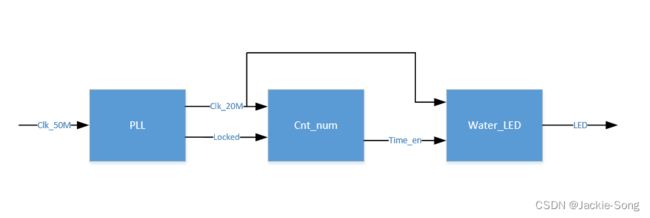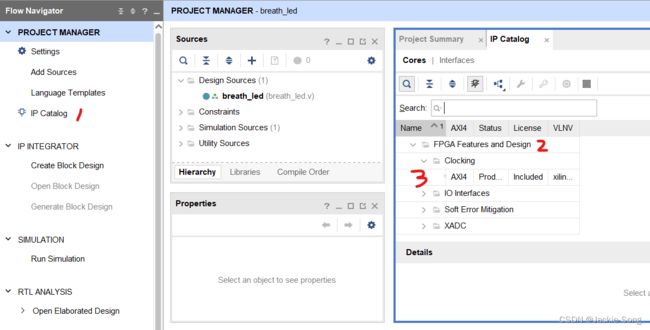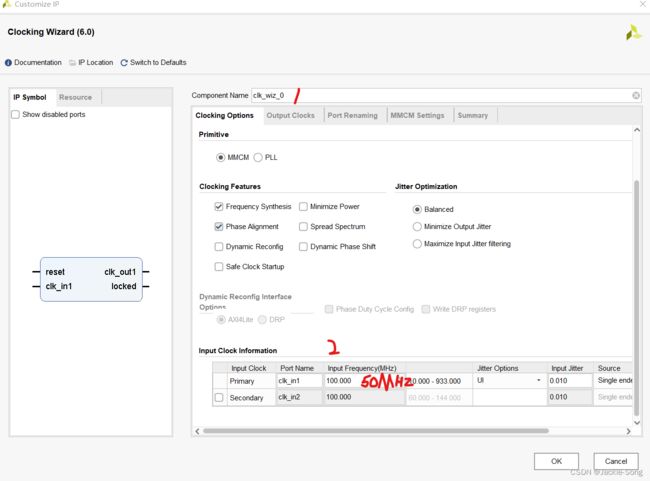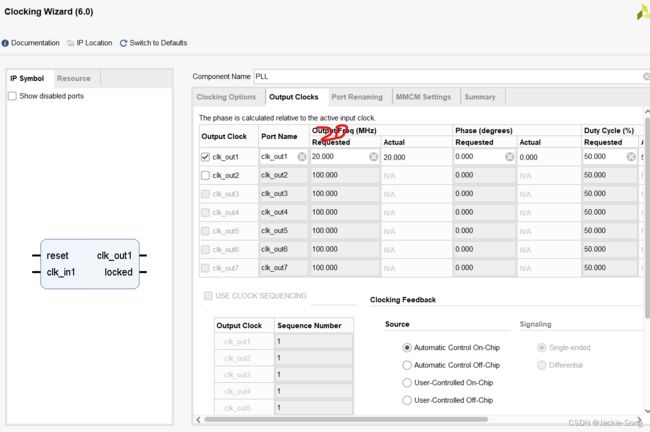FPGA-流水灯、呼吸灯
目标:设计一个20Mhz,并且依次点亮4个LED灯的实验
一、流水灯
FPGA实现流水灯主要运用移位操作。想要实现流水灯,就需要使一开始亮的那盏灯进行移位,若其中的LED为共阴极,则当信号为1(高电平)时,LED灯点亮,为0(低电平)时,LED灯熄灭。若假设四个LED灯一开始的电平为 0001 则根据流水灯的设计思路,流水灯的逻辑应该为0001->0010->0100->1000->0001。
(1)50Mhz -> 20Mhz (IP核的创建)
在50Mhz转20Mhz功能实现中,需要用到IP核中的PLL模块。首先打开左边中的IP核,选择FPGA FeaturesDesign,在空白中双击进入。
在进入之后会打开如下图的弹窗页面,然后将1处的名字改为PLL(可不改),并将2处的输入频率改为50Mhz,此处改为50Mhz相当于板子上的晶振为50Mhz
之后在Output Clocks菜单栏中,修改输出的频率,并且将输入的reset1取消掉,点击OK,既将IP核建立成功。详细如下图:
创建成功后需要调用IP核自动生成的函数,因此需要进行函数的查看。
双击PLL.veo
//----------- Begin Cut here for INSTANTIATION Template ---// INST_TAG
PLL instance_name
(
// Clock out ports
.clk_out1(clk_out1), // output clk_out1
// Status and control signals
.locked(locked), // output locked
// Clock in ports
.clk_in1(clk_in1)); // input clk_in1
// INST_TAG_END ------ End INSTANTIATION Template ---------
该函数为系统生成函数,在进行tb_PLL文件验证时,只需要将其进行复制,修改为自己设置的变量名称即可。下面附上tb_PLL代码块
`timescale 1ns / 1ps
module tb_PLL(
);
reg clk_in1;
initial begin
clk_in1=0;
end
always #10 clk_in1=~clk_in1;
PLL inst_PLL(
// Clock out ports
.clk_out1(clk_out1), // output clk_out1
// Status and control signals
.locked(locked), // output locked
// Clock in ports
.clk_in1(clk_in1)
); // input clk_in1
endmodule(2)计数器的创建
在进行流水灯设计时,需要将一盏灯点亮之后进行延时,延时工作完毕后,跳转下一盏流水灯亮,因此设计数器在此处充当延时功能。此处代码如下:
module cnt_time(
input clk,
input reset,
output time_en
);
reg [31:0]cnt_time=0;
parameter COUNT_MAX=31'd19_999_999;
always @(posedge clk) begin
if (reset) begin
cnt_time<=1'd0;
end
else if (cnt_time==COUNT_MAX) begin
cnt_time<=1'd0;
end
else begin
cnt_time<=cnt_time+1'd1;
end
end
assign time_en=(cnt_time==COUNT_MAX)?1'd1:1'd0;
endmodule(3)流水灯的设计
流水灯设计的核心思想是使用一个移位操作。首先设初始的四盏灯状态分别为1 0 0 0;如果当计数器计满所设定的数值时,该四盏灯进行移位操作,则 led<={led[0],led[3:1]}; 此处的含义为将最后一位移到最前面,将前三位的状态依次往后进行移位。此处代码如下:
//流水灯实验
module water_led(
input clk,
input time_en,
input reset,
output reg [3:0]led
);
always @(posedge clk) begin
if (reset) begin
led<=4'b1000;
end
else if (time_en) begin
led<={led[0],led[3:1]};
end
else begin
led<=led;
end
end
endmodule二、写顶层文件
经过IP核、计数器、流水灯三个文件已经写好了完成流水灯的所有模块,但是归根到底,该三个子函数没有进行相互的联系以及相互的串联,因此此处需要top顶层文件将三个子文件进行关联。此处代码如下:
module top_led(
input clk_in1,
output [3:0]led
);
wire clk_out1;
wire locked;
wire time_en;
PLL instance_name(
// Clock out ports
.clk_out1(clk_out1), // output clk_out1
// Status and control signals
.locked(locked), // output locked
// Clock in ports
.clk_in1(clk_in1)
); // input clk_in1
cnt_time inst_cnt_time(
.clk (clk_out1),
.reset (~locked),
.time_en (time_en)
);
water_led inst_water_led(
.clk(clk_out1),
.time_en (time_en),
.reset (~locked),
.led (led)
);
endmodule
//核心思想是将三个文件的信号源进行相互拼接注:需要注意reg wire, 避免在编写的时候搞混,以至于仿真无法跑通。
如下为tb_top文件:
//tb_top测试文件
module tb_top(
);
reg clk_in1;
wire [3:0]led;
initial begin
clk_in1=0;
end
always #10 clk_in1=~clk_in1;
top_led inst_top_led(
.clk_in1 (clk_in1),
.led (led)
);
endmodule
三、呼吸灯实验
待补充





